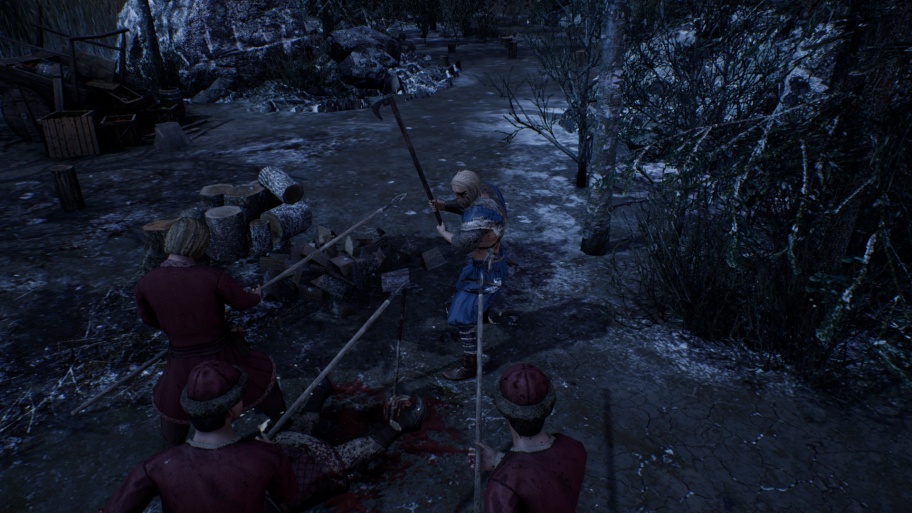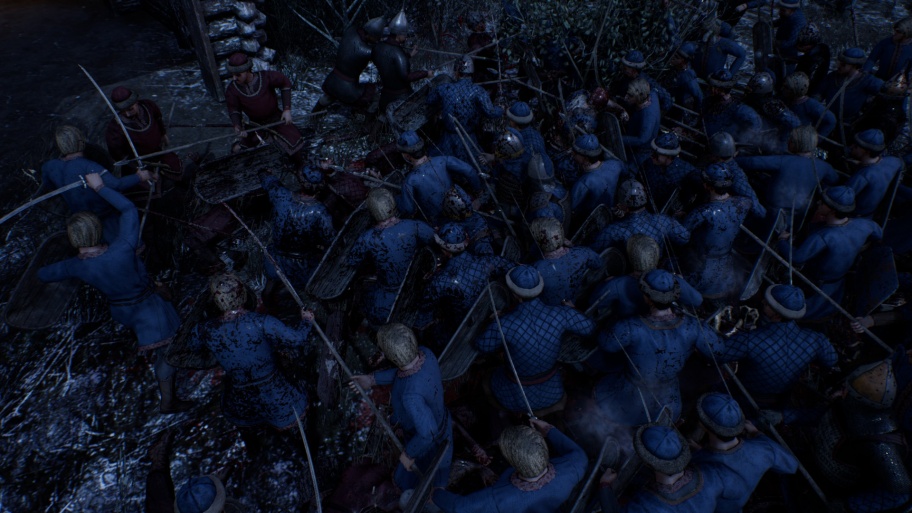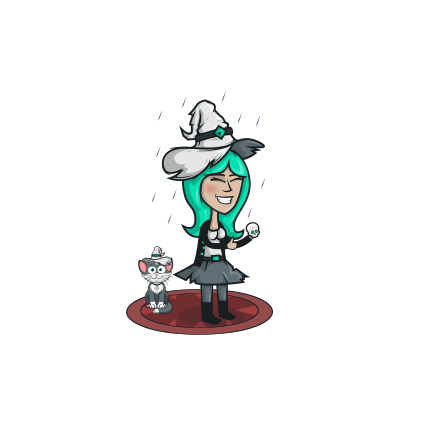The strategy genre with control points has spoiled its reputation.Company of Heroes 2 angered a bunch of people with its one-sided view of the Red Army. A Warhammer 40.000: Dawn of War III allowed itself to experience the mechanics, than to death offended that the fans of the first part, that the fans of the second, that fans of the desktop "wahi", who already hold the insult on the series for the influx of "doverastov."
Unexpectedly in this area is the Polish studio Destructive Creations , who suffered attacks for the simulator of the mass murderer Hatred and a strange shooting range on the wheels IS Defense, where the player shot a horde of "Igilov" from the machine gun. Bloodthirsty? And their third game is not alien to primitive rage.
Ancestors "imprisoned" for a network game, which did not prevent the authors to add several miniature campaigns for five missions in each. Here Vikings under your leadership are burning the rich abbey, here Edward the Confessor is preparing for a civil war with his influential vassal Godwin, but Rurik unites the Slavic tribes.
I do not recommend teaching history on subjects: real events were driven by the needs of the gameplay. Campaigns themselves are worthy of passing. Destructive Creations tried to aggravate the basic mechanics with cunning conditions. For example, assign a player to the AI-team-mate, who feeds at the expense of the player, burns the house, without grabbing the village, and even ineptly destroys entire units, taken away - that's right! - the player.
There are also secret assignments, and linear campaigns led by the heroes. Alas, almost all other missions after a certain line become copies of the usual "skirmish", where instead of the usual AI or live player against you a predictable "chiter" computer. It's not so inspiring, but you'll be practicing well before going to multiplayer.
Place and time are chosen not in vain. Military affairs have not yet reached great heights, and battles are fought with small forces. Maximum of one player - 10 units, in each - up to 10 people. The troops are primitive, but effective: spearmen, shield bearers, slingers and archers, feral from berserker mushrooms ...
Nations are not only the color of the flag. Differences between them are strong enough that a recipe for victory, suitable for the Vikings, was disastrous for the Slavs. The cavalry of the Scandinavians, for example, are flimsy scouts, two riders in the detachment. Even archers will not be flooded. But the Holy Roman Empire - heavy cavalry, which is not even afraid of copies.
Differences also affect the economy. Vikings can increase the rate of extraction of resources with the help of an upgrade, whereas the British do not have this opportunity. That is, the former can play from defense, and the latter - no, and if they are faced with a shortage of raw materials, then we will have to fight.
Battles in the game closer still to Dawn of War . In Ancestors for obvious reasons, there is no technology, and with it disappear ballistics and armor penetration, and supply, and much more.
Ancestors is very visual. The strip of "health" of the detachment is divided into small personal segments, and by their color it is possible to estimate how many wounds the fighter received. Wounds are not HP's conditional limit: each of them must be physically inflicted.
Not understood? Imagine two infantry detachments that attack each other. Between the warriors fencing scenes worthy of Total War are played out . Here is a man with an ax makes a swing at a spearman who, at the moment of blow, takes his deadly blade with his spear. Damage, if applied, is unrecordable or negligible. If the spearman had missed the blow, the ax would hit him on the shoulder, and his HP strip would change from green to yellow.
What does this mean for the player? The confrontation between the two teams is very dependent on additional factors, including animation. Shield-bearers in the protective rack will survive the first onslaught of the enemy almost without wounds, and in the usual they will necessarily be cut. Archers, slingers and crossbowmen fall to the ground from one kind of "melee", because in the animation of the fight they are pears for pounding.
At the same time, the arrows are a powerful force. Arrows are the same slaves of physics physics as people: a whistle past the arrow is wasted, but the one that hits the target hurts as it should. Three volleys of bows - and from a whole detachment there is a handful of wounded invalids. If the fighters do not catch up with the shooters before, of course, then the archers will be disabled.
The reverse side of this power is friendly fire. Long time ago I did not kill my troops with my own hands! A volley of arrows in a detachment of the enemy, bound by battle with your detachment, will not disassemble where your own, where the stranger is. Half certainly will stick in the allies. When the archers are close and shoot not by a canopy, but by direct fire, in the line of fire inevitably there will be backs of comrades-in-arms - then the enemy generally will not suffer damage, unlike your soldiers. Again you have to compare with Total War , where the ballistics is similar.
The battle picture from all this is complicated. The use of troop skills, the change of stance - not a whim, but an urgent need. You can not lead detachments in a crowd, otherwise they will get stuck in even one detachment of the enemy and will cut it as much as only one man would cope.
The control of arrows is an entire science. Shots in the manual mode must be combined with shooting at will and its prohibition, to kill the archers of the enemy before they have time to harm. It is especially important to find such a perspective, in which arrows do not hurt their own, for which it is often necessary to risk archers and push them behind the back of the enemy.
Finally, in Ancestors it's important to keep an eye on the health of the units, find a balance between "Okay, do it a little bit more" and "KARAUL, KILL, RUN BASE". "Run" is literally: the "Escape" button is not an extra function, but a regularly used tool. Only the flight will allow the infantry to break out of close combat and save at least a couple of soldiers. On the base or in the village, you can replenish the personnel of the platoon. To heal the same fighters are free anywhere, except for the battle: the platoon arranges a halt (sorry, without tents and bonfires - they just lie down to rest) and lick wounds.
Ancestors Legacy is made by a small team for little money, but it looks and is played as a solid strategy of noble blood, even if it appeared several years ago.
The game develops the idea of control points, forcing the player to follow whole areas where defenseless peasants harvest the forest or reap the wheat. In this case, Ancestors is a very compact game, with tight maps and small armies, which is compensated by the need for microcontrol. Friendly fire, squad positions, their health, active and switchable skills - aspects are enough to occupy the commander and to outwit them with the help of another commander: your opponent.
The trouble is that the compactness of the game extends to all its elements. There are very few clans of the troops, the difference between the types of infantry is small, there is no development of the territory - except that the turrets are protected in the village, which are demolished for one or two. After a few hours of dating, you notice: the structure of Ancestors is much easier than it seems. And this is not laconic, when a small number of elements are ideally matched to each other, but a vexatious oversight. And not fatal, in general.
Rate: 7 /10
Cheers! :)






Amazing.